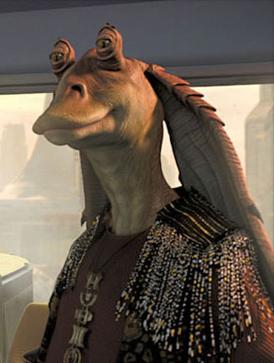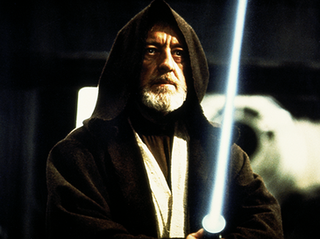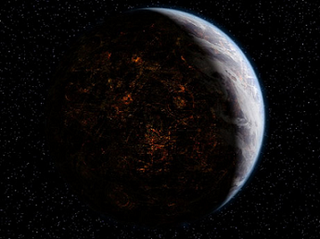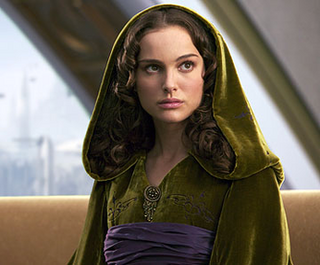
Jar Jar Binks is a fictional character from the Star Wars saga created by George Lucas. A member of the Gungan race, Jar Jar appears throughout the Star Wars prequel trilogy—as a major character in Star Wars: Episode I – The Phantom Menace and with a supporting role in Star Wars: Episode II – Attack of the Clones and Star Wars: Episode III – Revenge of the Sith—as well as having a role in the television series Star Wars: The Clone Wars. The first fully computer-generated supporting character in a live-action film, he has been voiced by Ahmed Best in most of his appearances, who also acted out the character with prosthetics prior to the CGI work. He also appears in various other media.

Star Wars: Episode I – The Phantom Menace is a 1999 American epic space opera film written and directed by George Lucas in his first directorial effort since 1977. The film stars Liam Neeson, Ewan McGregor, Natalie Portman, Jake Lloyd, Ahmed Best, Ian McDiarmid, Anthony Daniels, Kenny Baker, Pernilla August, and Frank Oz. It is the fourth film in the Star Wars film series, the first film of the prequel trilogy and the first chronological chapter of the "Skywalker Saga". Set 32 years before the original trilogy, during the era of the Galactic Republic, the plot follows Jedi Master Qui-Gon Jinn and his apprentice Obi-Wan Kenobi as they try to protect Padmé Amidala of Naboo in hopes of securing a peaceful end to an interplanetary trade dispute. Joined by Anakin Skywalker—a young slave with unusually strong natural powers of the Force—they simultaneously contend with the mysterious return of the Sith. The film was produced by Lucasfilm and distributed by 20th Century Fox.

Obi-Wan "Ben" Kenobi is a character in the Star Wars franchise. In the original film trilogy, he is a Jedi Master who trains Luke Skywalker in the ways of the Force. In the prequel trilogy, he mentors Luke's father, Anakin Skywalker. Obi-Wan is portrayed by Alec Guinness in the original trilogy and by Ewan McGregor in the prequel films. McGregor also plays the character in the television series Obi-Wan Kenobi. Guinness's performance in Star Wars (1977) earned him the Saturn Award for Best Supporting Actor, as well as a nomination for the Academy Award for Best Supporting Actor.

Count Dooku, also known as Darth Tyranus, is a fictional character in the Star Wars franchise. He was introduced in the prequel film trilogy, first appearing in Attack of the Clones (2002) and then returning in Revenge of the Sith (2005). He is portrayed by Christopher Lee in both films, and is voiced by Corey Burton in most of the video games and animated productions in which he appears. The animated productions include the series Clone Wars (2003–2005), The Clone Wars, and Tales of the Jedi (2022). Lee voices Dooku in the 2008 animated film The Clone Wars. Dooku also appears in novels and comics.

Qui-Gon Jinn is a fictional character in the Star Wars franchise. He was introduced as a Jedi Master in the prequel film The Phantom Menace (1999), and is portrayed by Liam Neeson. He appears in the series Tales of the Jedi, and is featured as a Force spirit in the animated series The Clone Wars (2008) and the live-action miniseries Obi-Wan Kenobi (2022). Qui-Gon also appears in novels, comics and video games.

The Galactic Empire, also known simply as the Empire, is a fictional autocracy featured in the Star Wars franchise. Introduced in the 1977 film Star Wars, it is the main antagonistic faction of the original trilogy, which also includes The Empire Strikes Back (1980) and Return of the Jedi (1983). An oppressive dictatorship with a complicated bureaucracy, the Galactic Empire seeks the rule and social control of every planet and civilization within the galaxy, based on anthropocentrism, nationalisation, state terrorism, power projection, and threat of lethal force.

The Rebel Alliance is an organization that features in the fictional world of the Star Wars franchise. The Alliance is portrayed as a stateless coalition of rebel dissidents and defectors who oppose the Galactic Empire and its authoritarian rule. Its stated goal is to restore the liberal governance of the previous Galactic Republic, which had been dissolved after its leader Palpatine seized absolute power and declared himself emperor. It is the main protagonistic faction of the original Star Wars trilogy.

Coruscant is an ecumenopolis planet in the fictional universe of Star Wars. It was first described in Timothy Zahn's 1991 novel Heir to the Empire. The planet made its first on-screen appearance in a scene added to Return of the Jedi for its 1997 re-release. It has gone on to become an important location in the Star Wars universe and appears frequently in Star Wars media. In-universe, Coruscant is a politically and strategically important planet, serving as the capital and seat of government for the Republic and the Galactic Empire, as well as the headquarters of the Jedi Order. It is depicted as a bustling, yet highly stratified planet-spanning metropolis. Throughout the city's centuries-long development, new city blocks were built on top of old ones, forming levels. Coruscant has 5127 levels, with the top being the wealthiest and the lowest being the poorest.

The Galactic Republic, commonly known as The Republic, is a fictional political entity in the Star Wars universe that predates the formation of the Galactic Empire. It is prominently featured in the prequel trilogy of Star Wars films, offering a glimpse into its history and functioning. In the original trilogy, which takes place after the events of the prequels, the Republic is referred to as the Old Republic, suggesting its long-established nature. In the prequel era, which takes place during the last years of the Republic, the term "Old Republic" referred to the Galactic Republic of ancient time, which was reorganized into the modern Republic a thousand years before the Battle of Yavin.

The Skywalker family is a fictional legendary human family in the Star Wars franchise. Within the series' fictional universe, the Skywalkers are presented as a bloodline with strong inherent capabilities related to the Force and sometimes lightsaber skills. Luke Skywalker, his twin sister Princess Leia Organa, and their father Darth Vader are central characters in the original Star Wars film trilogy. Darth Vader, in his previous identity as Anakin Skywalker, is a lead character in the prequel film trilogy and so is his wife and the twins' mother Padmé Amidala; while his mother Shmi is a minor character in the first and second films respectively. Leia and Han Solo's son, Ben Solo, renamed himself Kylo Ren and is the main antagonist in the sequel film trilogy, while they and Luke serve as supporting characters. Shmi, Padmé, and Han are the only members who are not Force-sensitive. The Skywalker bloodline, alongside the Palpatine bloodline, are the two bloodlines that are the strongest with the Force.

Star Wars: Galactic Battlegrounds is a real-time strategy video game set in the Star Wars universe. It was developed by LucasArts. It was released in November 2001. An expansion pack, Clone Campaigns, was released on May 14, 2002, adding two new factions and campaigns. Later that year, both Galactic Battlegrounds and Clone Campaigns were released in a box set, Star Wars: Galactic Battlegrounds Saga.
The Star Wars prequel trilogy, colloquially referred to as the prequels, is a series of epic space-opera films written and directed by George Lucas. It was produced by Lucasfilm Ltd. and distributed by 20th Century Fox. The trilogy was released from 1999 to 2005 and is set before the original Star Wars trilogy (1977–1983), chronologically making it the first act of the Skywalker Saga. Lucas had planned a prequel trilogy before the release of the original film, but halted major Star Wars films beyond the original trilogy by 1981. When computer-generated imagery (CGI) had advanced to the level he wanted for the visual effects he wanted for subsequent films, Lucas revived plans for the prequels by the early 1990s. The trilogy marked Lucas's return to directing after a 22-year hiatus following the original Star Wars film in 1977, as well as a 16-year hiatus between the classic and prequel trilogies.

Star Wars Episode I: Jedi Power Battles is an action Star Wars video game set during the time frame of Star Wars: Episode I – The Phantom Menace. The game was first released for the PlayStation, and afterwards for the Dreamcast and the Game Boy Advance. A remastered version of the game is scheduled to release for Windows, Nintendo Switch, PlayStation 4, PlayStation 5, Xbox One, and Xbox Series X/S in January 2025.

Star Wars: Obi-Wan, originally titled Star Wars: Episode I: Obi-Wan, is a 2001 action-adventure video game developed and published by LucasArts and released exclusively for Xbox on December 19, 2001 in North America and March 29, 2002 in Europe. It is set in the Legends canonicity of the Star Wars universe. Players control the Jedi Obi-Wan Kenobi around 32 years before the Battle of Yavin, shortly prior to and during the events of the 1999 film The Phantom Menace. The game received generally mixed reviews upon its release.

Star Wars: Episode I – The Phantom Menace is a 1999 action-adventure video game developed by Big Ape Productions and published by LucasArts for Windows and the PlayStation. An adaptation of the film of the same title, players take on the role of Qui-Gon Jinn, Obi-Wan Kenobi and several other characters in a near-identical retelling of the film. Each playable character has a unique weapon and ability.

Sheev Palpatine is a fictional character in the Star Wars franchise. He first appeared in the 1980 film The Empire Strikes Back as The Emperor. He is also known by his Sith name, Darth Sidious, which was first used in the novelization of the 1999 film The Phantom Menace.

Darth Maul is a character in the Star Wars franchise created by George Lucas. He first appeared in the prequel film Star Wars: Episode I – The Phantom Menace (1999). Maul returned in the animated television series Star Wars: The Clone Wars and Star Wars Rebels (2014–2018), as well as the standalone film Solo: A Star Wars Story (2018). Lucas had intended for Maul to feature in the sequel film trilogy, but these plans were discarded when Disney acquired Lucasfilm in 2012.

Mace Windu is a fictional character in the Star Wars franchise. He was introduced in the prequel trilogy as a Jedi Master who sits on the Jedi High Council during the final years of the Galactic Republic. He is portrayed by Samuel L. Jackson in all three prequel films. Windu also appears in the 2008 animated film The Clone Wars, the television series of the same name, and in novels, comics, and video games.

Padmé Amidala is a fictional character in the Star Wars franchise. She first appeared in the 1999 film The Phantom Menace as the teenage queen of the fictional planet Naboo. In the following two films of the prequel trilogy, Padmé becomes a member of the Galactic Senate and secretly marries Anakin Skywalker, a Jedi Knight. Anakin's fear of losing Padmé drives him toward the dark side of the Force, which results in his transformation into Darth Vader. Padmé eventually dies after giving birth to the twins Luke Skywalker and Leia Organa. Natalie Portman portrays Padmé in all three prequel films. In addition to films, Padmé appears in animated series, novels, comics and video games.


















